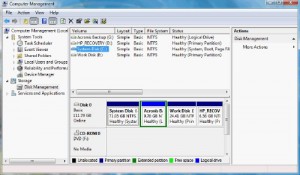by David Hakala
Q: Is the recovery partition of Vista really needed? Can I remove it? If I can remove it, what is a procedure to remove this partition? – Don
Vista’s recovery partition is needed like a car’s spare tire is needed. The car will run fine without a spare tire and you will free up some trunk space by removing the spare tire. You can keep the spare tire in your garage at home, and go get it when one of your tires goes flat. But better hope the car is in your driveway when a tire goes flat.
The recovery partition takes up a lot of disk space – a couple of dozen gigabytes by default. It’s tempting to delete that partition, but it’s your safety net in case your Vista installation crashes. The recovery partition holds all of the files necessary to restore your computer to its factory-fresh condition with a working copy of Vista. It’s also used to hold “restore points,” snapshots of your data files and settings at given points in time. Restore points enable you to restore your computer to a previous state if, for example, installation of a new software package goes horribly wrong. You don’t want to simply delete these capabilities, you want to move them off your hard drive to offline storage.
One way to do this is to contact your PC’s maker and request a set of recovery discs. Some vendors are more cooperative than others, but with persistence and perhaps a nominal fee you can usually get a set of discs mailed to you. Put the discs in a safe place.
Another option is to purchase a full retail copy of Vista. But that costs a few hundred dollars.
Do not mistake the “make recovery disk” option in Vista with the recovery partition on your PC. The former merely creates a bootable disc that can be used by advanced users to repair a damaged Vista installation. It will not re-install Vista if that is necessary.
Once you have a full-installation set of Vista recovery discs, you can delete the recovery partition on your hard drive and merge that freed space into your primary partition.
Click Start, then right-click on Computer, and select Manage
In the left pane, under Storage, click on Disk Management
Right-click on the reformatted (empty) recovery partition and select Delete
Right-click on the primary partition and select Extend
Follow the instructions to extend your primary partition into the disk space freed by deleting the recovery partition.
David Hakala has perpetrated technology tutorials since 1988 in addition to committing tech journalism, documentation, Web sites, marketing collateral, and profitable prose in general. His complete rap sheet can be seen at http://www.linkedin.com/in/dhakala

{ 3 comments }
I have an Acer Aspire M1100 desktop that I bought last year, and just here recently I found out how important the recovery partition is. The computer completely, with some of my help, crashed on me, and I went into a depressive shock, until I called Acer Support, and Acer woman gave me directions over the phone how to use the recovery partition, and re-install Vista. I have used it a few times since then. I also went to the Acer Support eRecovery website and downloaded all the software to re-install Vista also, about 6 discs. It is now a good feeling to have that Recovery Partition, and the discs, when I will at sometime in the future, more than likely need them again. It’s like insurance.
will a recovery disc restore only vista while maintaining all previous files
and desktop icons and other information on the harddrive
The recovery DVD’s that are created should be enough, after all they are meant to be able to recover from a full hard disc failure., they normally write an image to the drive as per when the laptop/PC was purchased. An issue with laptops is that they create 4 partitions by default – two EISA partitions and a C & D drive. Whilst C & D drives are great leaving no free partitions mean that if you wish to try LINUX or OpenSolaris you cannot without deleting the recovery partitions. I believe once you have created the recovery DVD’s (and checked that they work) you can safely remove the recovery partitions – I have done this on HP tablets and it all install perfectly well.
Comments on this entry are closed.